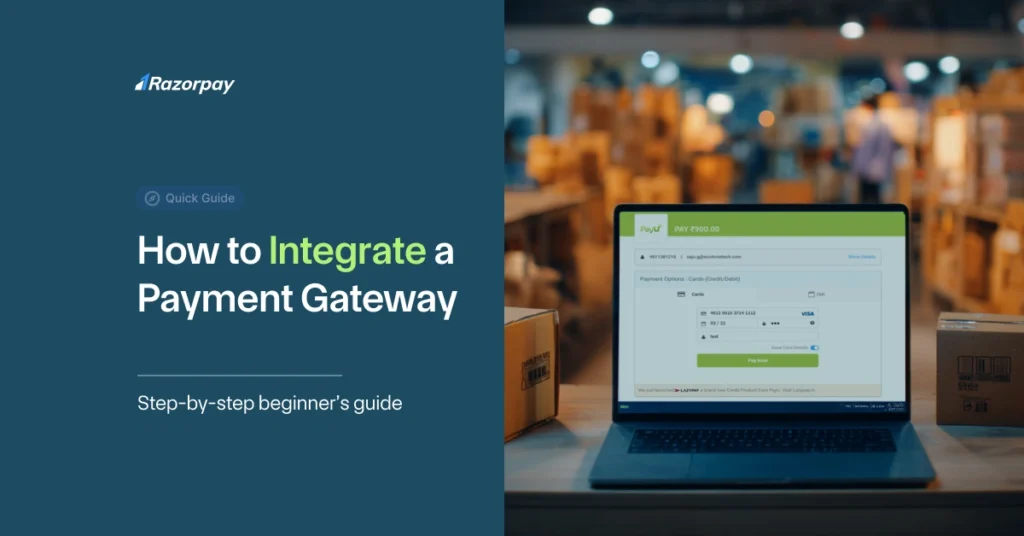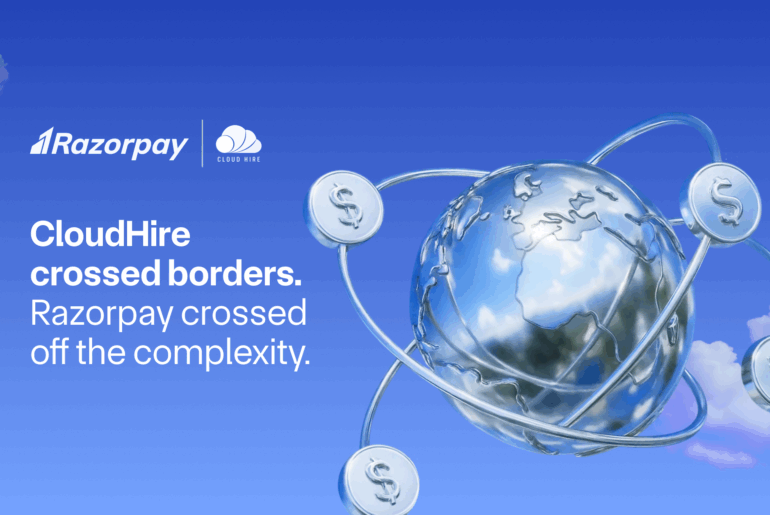With digital payment transactions in India crossing ₹8,659 crore in just the first five months (April to August) of FY 2024–25, the need for seamless payment integration has never been more urgent.
To start accepting online payments on your site, it’s essential to understand how to implement a payment gateway on your website to ensure secure and seamless transactions. In this guide, you’ll learn exactly what technical requirements you must meet, how to configure settings and APIs, and which security best practices to follow.
Whether you’re a small business owner with limited coding experience or a developer seeking advanced customisation, these seven steps will walk you through the entire process. By the end, you’ll have a fully functional payment gateway—ready to process transactions smoothly and safely.
Table of Contents
Which Payment Gateway Should You Use?
Choosing the right payment gateway depends on several key factors. Start by assessing your business model. If you run a high-volume e-commerce store, you’ll need a gateway that supports multiple payment methods and handles large transaction volumes without delays. For smaller businesses, ease of setup and affordability might be more important.
Next, consider your target audience. If your customers prefer UPI, net banking, or wallets, pick a gateway that supports these methods. Many Indian consumers use UPI and mobile wallets, so ensuring compatibility can directly impact your conversion rates.
Security and compliance are also critical—choose a gateway that’s Payment Card Industry Data Security Standard (PCI-DSS) certified and offers fraud protection. Ensure it supports two-factor authentication and secure encryption. Also, review transaction fees carefully, as they directly affect your margins and cash flow.
How to Pick the Right Payment Gateway for Your Website?
To choose the best payment gateway for your website, evaluate each option based on your business goals, customer base, and technical requirements. Look at how easy it is to integrate with your website, whether it offers a smooth checkout experience for users, and how well it can scale as your business grows. Below are the key points to evaluate.
1. Customer Location and Preferences
Start by identifying where your customers are based and how they prefer to pay. If you serve mostly Indian customers, make sure the gateway supports UPI, RuPay cards, and local wallets. For international buyers, pick a gateway that accepts international credit and debit cards and can process payments in multiple currencies.
2. Supported Payment Methods
Your gateway should cover all major payment methods—credit/debit cards, UPI, net banking, and wallets. The more options you offer, the higher your chances of completing a sale. Some gateways also support EMI and “Buy Now, Pay Later” options, which can be useful for high-ticket items.
3. Security and PCI-DSS Compliance
Pick a gateway that follows PCI-DSS guidelines to protect cardholder data. Ensure it uses strong security measures like encryption, fraud detection, and secure authentication methods. This helps keep transactions safe, builds customer trust, and reduces the risk of data breaches or payment fraud.
4. Transaction Fees and Pricing
Check how the payment gateway charges you—per transaction, monthly, or both. Compare rates for different payment modes. Also, take into account any setup fees, charges for refunds, and how quickly you receive your settlements. Choosing a cheaper option might end up costing you more in the long run if the settlement process is slow or customer support is weak.
5. Type of Integration
Payment gateways vary in how they integrate with your website. Some offer easy plug-and-play options ideal for quick setup, while others require API integration for more customisation. Choose the type that fits your technical skills and business needs. Additionally, ensure the gateway works smoothly on both mobile and desktop devices to reach all customers effectively.
Types of Payment Gateway Integrations
1. Hosted Payment Gateway
A hosted gateway takes your customer away from your website to a secure payment page managed by the provider. Once the transaction is complete, they are redirected back to your site.
This is the easiest option to set up and doesn’t require you to handle sensitive payment data, making it a good choice if you lack in-house tech support. Security is handled by the provider, so you don’t need to worry about PCI DSS compliance. However, because customers are redirected off-site, it can slightly disrupt the buying experience.
2. Integrated Payment Gateway
An integrated gateway allows customers to enter their payment details directly on your website, while the processing happens in the background through the provider’s API.
This setup offers a smooth, uninterrupted checkout experience and keeps users on your site, which can build trust and improve conversions. However, it requires a bit more technical effort to implement and maintain. You’ll need to ensure proper security measures, including Secure Sockets Layer(SSL) certification and possibly PCI compliance, depending on the data flow.
3. Direct Post Payment Gateway
With a direct post integration, customers submit their payment details on your site, but the data is sent straight to the gateway’s servers for processing, bypassing your own server.
This approach gives you full control over the checkout design while reducing your PCI compliance burden. It does involve some coding and backend configuration, so it’s better suited for businesses with technical support. The user experience remains smooth and consistent, with no redirection involved.
How Hard Is It to Add Payments to Your Website?
Adding payment options to your website can be easy or a bit technical, depending on your skills and the platform you use. If you use common website builders, it’s usually quick and simple. But if you want more control or custom features, it takes more time and coding knowledge.
1. Basic Integration
Basic integration involves using pre-built plugins or modules designed for popular e-commerce platforms or website builders. This method is straightforward and often requires minimal technical skills. You can usually get it up and running within a few hours, making it ideal for small business owners or those without a developer on hand.
2. Advanced Integration
Advanced integration uses APIs to connect the payment gateway directly to your website’s backend. This offers greater flexibility and control, allowing you to customise the payment flow, add multiple payment options, and enhance security features. However, it requires developer expertise and can take several days to complete, depending on the complexity of your site.
Step-by-Step Guide to Payment Gateway Integration for an E-commerce Site
Step 1: Choose a Payment Gateway
Start by evaluating payment gateways that support the payment methods your customers use most—UPI, credit/debit cards, wallets, and net banking. Look at transaction fees, settlement timelines, and support for Indian and international payments.
If you’re a developer, consider whether the provider offers strong API documentation and Software Development Kit (SDKs) for your tech stack.
Step 2: Sign Up and Create a Merchant Account
Once you’ve chosen a gateway, register for a merchant account on their platform. You’ll need to submit KYC documents like your PAN card, business registration, bank account details, and GST certificate (if applicable). Payment providers may take around 3–4 working days to complete the activation.
Step 3: Get API Credentials
After your account is approved, you’ll receive API credentials—these are like login details for your website to connect with the payment system. You’ll usually get an API key, a secret key, and URLs to send and receive data. Keep these safe. Never share them publicly or expose them in your website’s code.
Step 4: Set Up Your Website for Payments
Now, you’ll integrate the gateway into your website. If you’re using a platform like Shopify or WooCommerce, the process may involve simply installing a plugin or extension.
For custom websites, you’ll need to use the gateway’s APIs or SDKs to create payment forms, initiate transactions, and receive payment status updates from the gateway. Make sure your site uses HTTPS and is SSL-certified to ensure secure data transmission.
Step 5: Test the Integration in Sandbox Mode
Most providers offer a sandbox or test environment. Use this to simulate real transactions and confirm that the payment flow works as expected, from payment initiation to confirmation.
Check for issues like incorrect amounts, failed redirects, or missing order confirmations. Fix all bugs before going live.
Step 6: Go Live with Payments
After testing, switch from sandbox to live mode by replacing test credentials with live ones. Recheck all configurations, especially the webhook and return URLs, to ensure accurate order status updates and customer redirection after payment.
Once live, your customers can start making real payments.
Step 7: Monitor and Maintain the Integration
Once your payment gateway is live, regularly monitor transactions, settlements, and error logs. Enable alerts for failed transactions or downtime. Make sure all API versions remain up to date, and revisit your security settings periodically.
If you’re handling development, keep the integration code clean and well-documented for future updates or audits.
What Does It Cost to Integrate a Payment Gateway?
Integrating a payment gateway comes with a mix of one-time and ongoing costs. Some are fixed, while others vary based on your transaction volume or technical setup. Knowing these in advance helps you avoid surprises and plan your budget better.
1. Account Setup Fee
Many payment providers charge a one-time account setup fee. This covers your business verification and account activation process. Many popular providers in India, like Razorpay, offer free account creation. However, some others may charge up to ₹4,200 depending on their onboarding process.
2. Gateway Setup Fee
The gateway setup fee is charged to enable the payment gateway service on your website. It usually includes basic configuration and initial technical support. Many providers waive this fee, but some may charge between ₹4,300 and ₹21,400, especially for high-risk businesses or custom integrations.
3. Merchant Account Fee
A merchant account is where customer payments are held before they move to your bank. Providers may charge monthly or annual fees for maintaining this account and these fees typically range from ₹0 to ₹8,500. If your business processes high volumes, some gateways offer discounted merchant accounts.
4. API Integration Fee
If you need a custom integration using APIs, some providers charge an additional fee. The cost for this can range from ₹8,500 to ₹42,800, depending on the website complexity and the developer’s rates. This covers developer support, access to developer tools, and advanced features.
5. SSL Certificate Cost
An SSL certificate encrypts data between your website and your customers, keeping payments secure. While some hosting providers include SSL for free, paid certificates can cost anywhere from ₹850 to ₹17,200 per year ,depending on the level of security and brand. Without it, most payment gateways won’t allow you to go live, as it’s required for secure transactions.
6. Plugin or Module Fees
Many e-commerce platforms support payment gateway integration through plugins or modules. While some are free, others can cost up to ₹17,200 depending on the features and provider. Always check for compatibility with your platform and ensure the plugin is regularly updated and supported before making a purchase.
7. Custom E-commerce Development Cost
If you hire developers to build or customise your payment system or online store, this adds to your costs. Charges depend on the complexity and the developer’s rates. You may end up spending anywhere between ₹42,800 and ₹4,28,000 based on the scope of work. Investing in custom development can pay off with better user experience and tailored features.
How to Integrate Razorpay into Your Website?
-
Create a Razorpay Account: Sign up on the Razorpay Dashboard and complete the onboarding steps. Once done, you’ll get access to your API keys.
-
Generate API Keys: Go to Account & Settings → API Keys in the dashboard and then click on Generate Key to generate the API Key for live mode. These are required to connect your site with Razorpay’s system.
-
Set Up Orders on the Server: Use Razorpay’s Orders API to create an order on your server. This generates an order_id, which links a customer’s payment to a specific transaction.
-
Add Razorpay Checkout to Your Website: Razorpay offers a ready-to-use checkout form that you can place on your site. You can customise it with your branding and configure it to collect details like name, email, and phone number.
-
Test the Integration: Before going live, test the checkout using Razorpay’s sandbox mode and dummy card/UPI details. This ensures everything is working properly.
-
Go Live: Replace the test API keys with your live keys and switch your site to production. Confirm your payment capture settings and ensure all transactions are verified securely.
Conclusion
Integrating a payment gateway into your website is essential if you want to accept online payments securely and efficiently. You’ve now seen the three main types of integrations, the exact steps to follow, and the possible costs involved. Whether you use a hosted solution or a fully integrated setup, it’s important to choose a gateway that fits your business needs and technical ability.
Start with a trusted provider, follow the setup carefully, test everything, and keep monitoring your system after going live. With the right integration, you’ll offer your customers a smooth and secure checkout experience while building trust and driving more sales.
FAQs
Q1. How long does it take to integrate a payment gateway?
Integrating a payment gateway can take anywhere from a few hours to a few days. If you’re using a platform like Shopify, WooCommerce, or Wix with built-in plugins, it can be done within a couple of hours. For custom-built websites, the process may take a little longer, depending on the complexity and whether a developer is involved.
Q2. Can I integrate multiple payment gateways on my website?
Yes, you can use more than one payment gateway. Many e-commerce sites do this to offer more payment options or to reduce downtime if one provider faces issues.
Q3. Do I need coding skills to integrate a payment gateway?
Not always. If you’re using ready-made platforms with plugins, you won’t need coding. But for custom websites, basic coding or developer support is usually required.
Q4. How do I test if my payment gateway is working?
Use the sandbox mode provided by your gateway. It lets you simulate transactions without using real money. Check if payments are successful, confirmations appear, and orders are recorded correctly.


